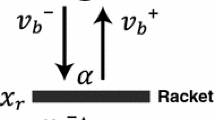Abstract
Haptic devices have been studied as a useful tool for motion instruction. In this paper, we take up the method in which the device momentarily instructs the learners to reduce errors of their reproduced movements by giving force. Subjects trained two-stroke hand motions on a horizontal plane. The subjects learned lengths, angles, and velocities of each of the two strokes. The device-exerted force was calculated by multiplying a stiffness to the momentary joint angular errors. The servomotor stiffness with respect to a geared-motor rotation was chosen from 0.5, 1.5, 4.5, 13.5, and 40.5 N cm/deg. The experiment constituted of the training stage and the short-term recall stage. In the instruction trials, subjects were asked to “actively” conduct their recognized movement and to modify their momentary movements, perceiving the device-forced passive movement and/or device-exerted force. The experimental results showed that the reproduction errors in the short-term recall stage under the larger stiffness conditions were approximately smaller. However, the error reduction of the length tended to converge for 4.5 N cm/deg or more condition, and the error reductions of the angle and average velocity tended to converge for 13.5 N cm/deg or more condition. In addition, maximum device forces given in the instruction trials tended to increase as the stiffness increased.













Similar content being viewed by others
References
Wong JD, Kistemaker DA, Chin A, Gribble PL (2012) Can proprioceptive training improve motor learning? J Neurophysiol 108(12):3313–3321
Smeets JB, van den Dobbelsteen JJ, de Grave DD, van Beers RJ, Brenner E (2006) Sensory integration does not lead to sensory calibration. Proc Natl Acad Sci 103(49):18781–18786
Bernardi NF, Darainy M, Ostry DJ (2015) Somatosensory contribution to the initial phases of human motor learning. J Neurosci 35(42):14316–14326
Shadmehr R, Smith MA, Krakauer JW (2010) Error correction, sensory prediction, and adaptation in motor control. Annu Rev Neurosci 33:89–108
Takiyama K, Hirashima M, Nozaki D (2015) Prospective errors determine motor learning. Nat Commun 6:5925
Lönn J, Djupsjöbacka M, Johansson H (2001) Replication and discrimination of limb movement velocity. Somatosens Motor Res 18(1):76–82
Snapp-Childs W, Casserly E, Mon-Williams M, Bingham GP (2013) Active prospective control is required for effective sensorimotor learning. PLoS One 8(10):e77609
Fitts PM (1964) Perceptual-motor skill learning. In: Melton AW (ed) Categories of human learning. Academic Press, Cambridge, pp 243–285
Nakamura R (1994) Motor learning. J Exerc Physiol 9(3):149–156 (in Japanese)
Acknowledgements
This work was supported by KAKENHI [Grant-in-Aid for Scientific Research (B) 15H02929 from JSPS].
Author information
Authors and Affiliations
Corresponding author
About this article
Cite this article
Akatsuka, F., Nomura, Y., Sugiura, T. et al. An exoskeletal motion instruction with active/passive hybrid movement: effect of stiffness of haptic-device force-feedback system. Artif Life Robotics 24, 161–171 (2019). https://doi.org/10.1007/s10015-018-0504-4
Received:
Accepted:
Published:
Issue Date:
DOI: https://doi.org/10.1007/s10015-018-0504-4




